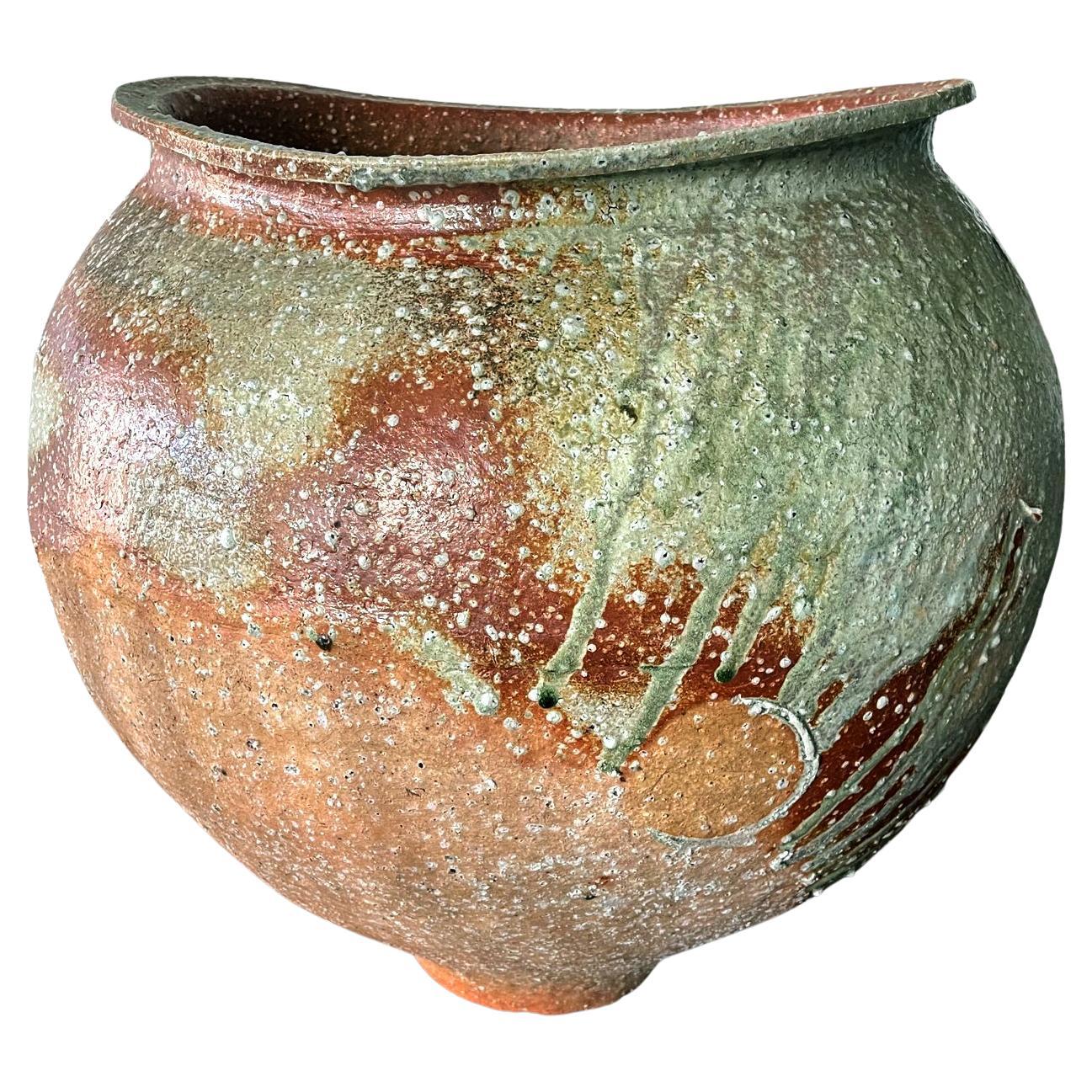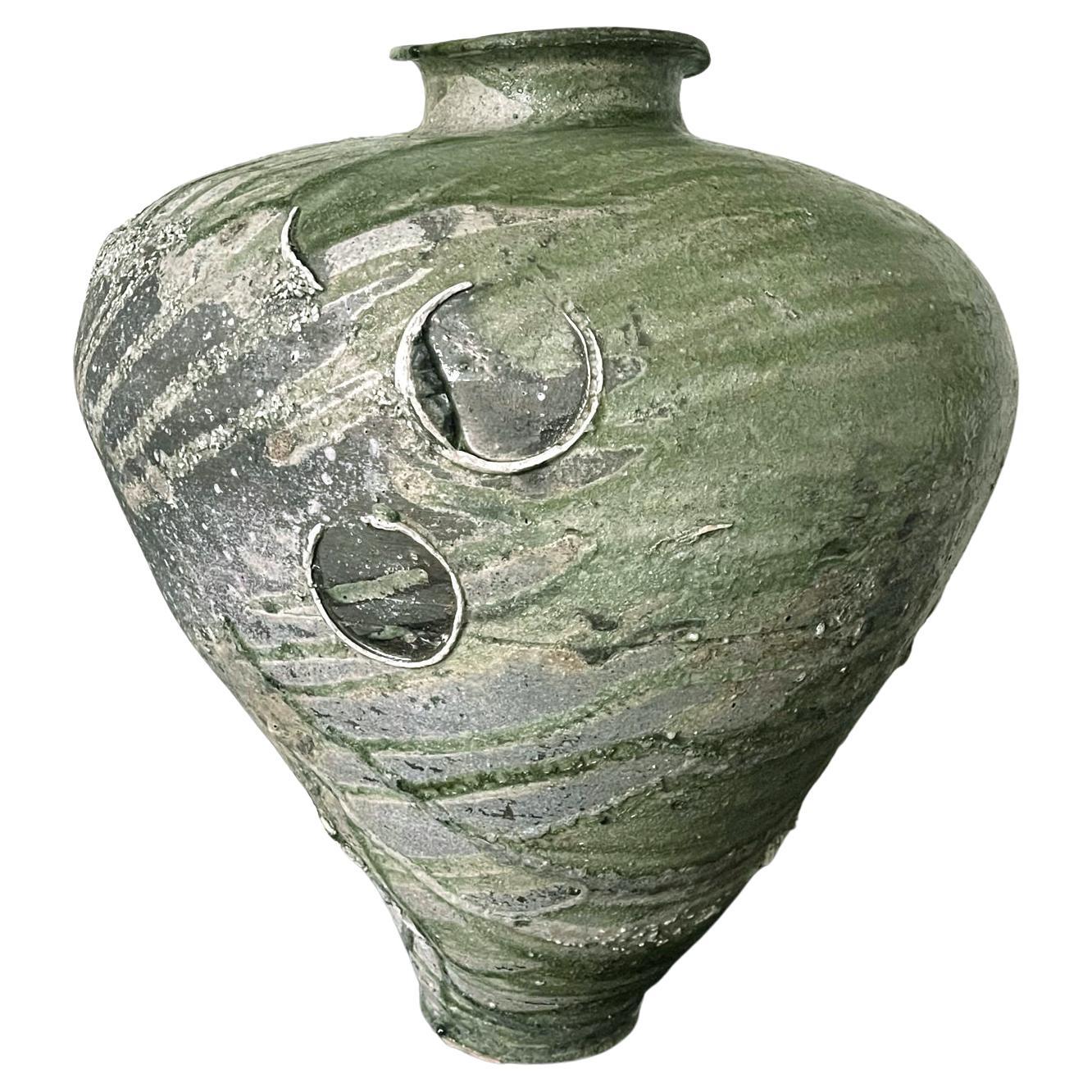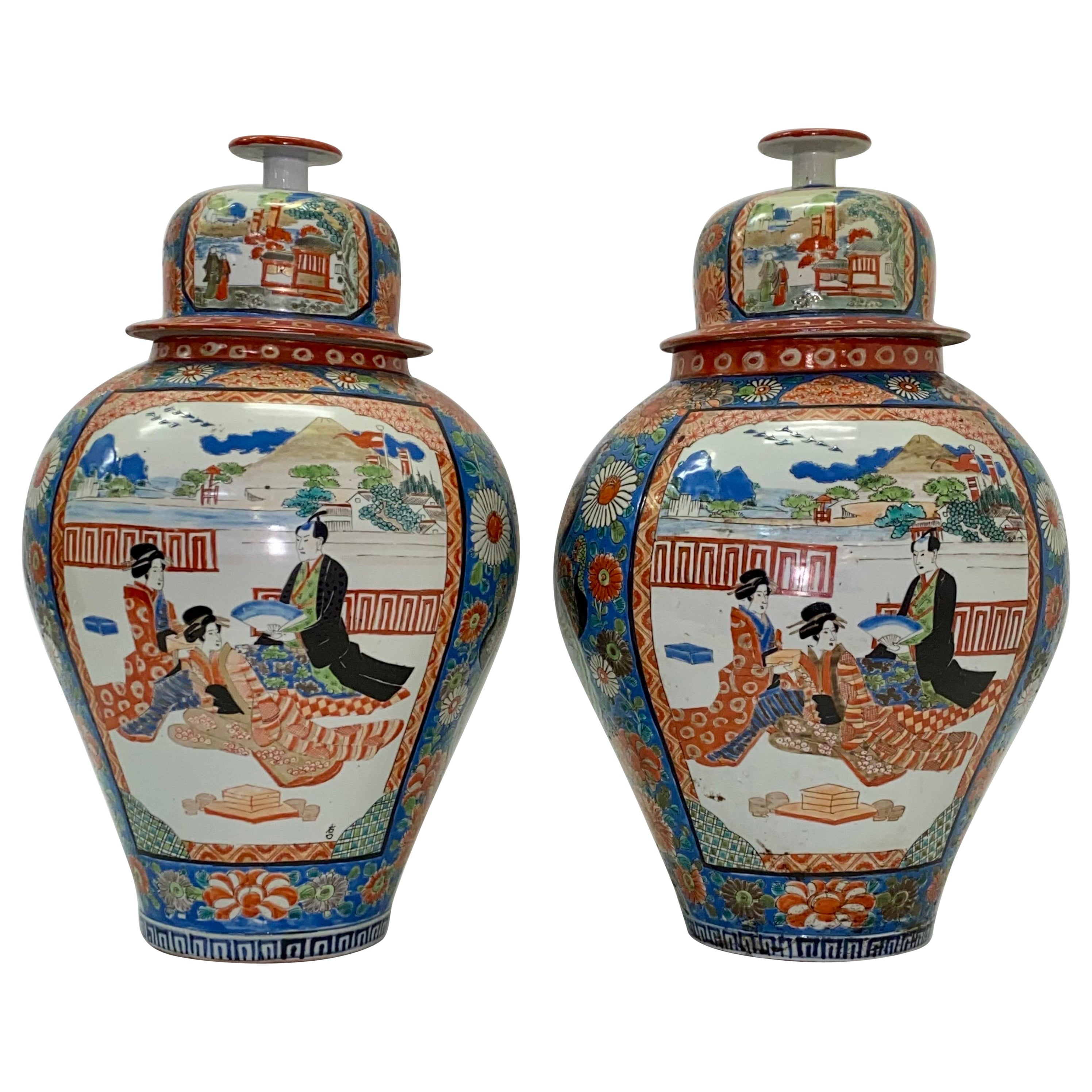Items Similar to Large Japanese Contemporary Ceramic Jar from Onda Yaki Kiln
Want more images or videos?
Request additional images or videos from the seller
1 of 15
Large Japanese Contemporary Ceramic Jar from Onda Yaki Kiln
About the Item
A large Japanese lidded ceramic jar from the kiln of Onda Yaki, circa 2010. The stoneware jar impresses the viewer with a robust bulbous form. Its black body is nearly unglazed but exuberantly splashed with strokes of slip glazes of white, yellow and blue. The visual effect is wonderful that it appears traditional and contemporary at the same time. The tri-color glaze calls to mind the San-Cai from Chinese Tang dynasty, yet the application is akin to abstract painting on canvas.
Onda Yaki also spelled as Onta Yaki also spelled Onta, is a type of Japanese pottery produced in and around the village of Onta in Oita Prefecture in Kyushu Island. It was founded in 1705. Closely associated with Mingei folk art, Onda ware was inscribed by the national government in 1995 as an Intangible Cultural Property
Background from Pucker Gallery where the jar was exibited and purchased.
"In his search for true folk pottery, the Japanese philosopher Soetsu Yanagi (1889-1961) discovered the community of Onda Sarayama (Japanese for "Plate Mountain") on the island of Kyushu in Japan. Little has changed about the process and aesthetics of ceramic production in Onda since that time. Currently, ten of the fourteen families inhabiting the area participate in pottery production; the eldest son is the only person who is allowed to throw the pottery. This community works together using locally sourced clay to create iron-rich, functional pieces. There is a strong focus on slip decoration via brushwork, chattering, and dripping with a free and energetic approach."
Provenance: Pucker Gallery, Boston, 2010.
Exhibited: Pucker Gallery, Boston, "Keeping Tradition: The Ceramic Art of Onda", January 23rd-March 8th, 2010.
Publication: Pucker Gallery, Keeping Tradition: The Ceramic Art of Onda, Boston: 2010, pp. 12, fig. 855.
- Creator:Onda Yaki (Maker)
- Dimensions:Height: 18.5 in (46.99 cm)Diameter: 17 in (43.18 cm)
- Style:Organic Modern (Of the Period)
- Materials and Techniques:
- Place of Origin:
- Period:
- Date of Manufacture:2010
- Condition:Wear consistent with age and use. Fine condition with only minor contact wear on the base as shown.
- Seller Location:Atlanta, GA
- Reference Number:1stDibs: LU945027354302
About the Seller
5.0
Platinum Seller
These expertly vetted sellers are 1stDibs' most experienced sellers and are rated highest by our customers.
Established in 2006
1stDibs seller since 2010
479 sales on 1stDibs
Typical response time: <1 hour
- ShippingRetrieving quote...Ships From: Atlanta, GA
- Return PolicyA return for this item may be initiated within 2 days of delivery.
More From This SellerView All
- Large Contemporary Ceramic Tsubo Jar by Kai TsujimuraLocated in Atlanta, GAA massive stoneware tsubo floor jar created by Japanese contemporary ceramic artist Kai Tsujimura (1976-). The heavy jar with its impressive volume was made in the tradition of Iga ware with local coarse sandy clay that turned reddish after the firing. It took its shape from heavy medieval storage jars with a wide-open mouth. For a nearly identical form, see an Echizen jar from Heian period (794–1185) in the collection of MET (Accession Number: 1977.261). The surface showcases scattered white crystalized feldspars and a green vitrified ash glaze cascade down the body (known as biidoro in Japanese - after the Portuguese word for glass vidoro). These is a globular shape impressed on the jar. It is a signature practice of the Tsujimura potter family by stacking bowls between the pieces in the kiln during the firing, resulting in an accidental but iconic aethetic (Kai and Yui Tsujimura...Category
2010s Japanese Organic Modern Ceramics
MaterialsStoneware
- Large Japanese Antique Shigaraki Tsubo JarLocated in Atlanta, GAAn antique Japanese stoneware storage jar, known as tsubo from Shigaraki kiln, circa 17th-18th century (early Edo possibly Momoyama period)....Category
Antique 17th Century Japanese Japonisme Ceramics
MaterialsCeramic
- Massive Ceramic Jar Tsubo by Japanese Potter Tsujimura YuiBy Tsujimura YuiLocated in Atlanta, GAA massive and magnificent ceramic Tsubo jar by Japanese potter Tsujimura Yui (1975-). Inspired by the techniques and aesthetics of the early medieval Sue ware, the artist hand builds an impressive voluminous oviform, irregular by intention, from a combination clay from both Shigaraki and Iga, coarse by nature and rich in feldspar. Fired on their sides horizontally, the surface of the thick wall tsubo is covered with streaks and drips of natural ash glazes in shades of green and blue, forming an abstract and mesmerizing pattern that resembles geothermal earth activity. Additional ashes are blown during the firing to accentuate the textures. Most recognizably, there are many circular marks scattered on the surface of his archaic looking vessels. That is resulted from using stacked tea bowls to prevent the conjoining of the vessels. After the firing, the stacked vessels are chipped away, leaving behind those circular impression, as well as deep pools of glaze which gather where they were placed. Born in 1975, Tsujimura Yui is the first son of the contemporary ceramic artist Tsujimura Shiro...Category
Early 2000s Japanese Modern Ceramics
MaterialsCeramic
- Japanese Modern Studio Ceramic Oribe Jar by Ryoji KoieBy Ryoji KoieLocated in Atlanta, GAA glazed ceramic vessel by Japanese potter Ryoji Koie (1938-2020). Hand-built with intention to be seen as such, the tsubo has a primordial irregular form with a small opening and a swelled body resembling a beehive. The upper body was covered in a glassy green oribe glaze with fine crackles, highlighted with three incised geometrical symbols. The lower body is unglazed and exposed the white clay with marks of the hand-making pinches and kneading along the base. The base also shows highly irregular surface due to the seashell spur marks and clay pitting in the kiln during the firing process. All these occurrences honestly preserved and presented as part of the character of this wonderful modern piece. The jar comes with a plain wooden tomobako box. "One of Japan’s most versatile and forward-thinking contemporary artists, KOIE RYOJI...Category
21st Century and Contemporary Japanese Modern Ceramics
MaterialsCeramic
- Large Japanese Satsuma Ceramic Vase KinkozanBy KinkozanLocated in Atlanta, GAA large Japanese ceramic vase from the end of Meiji period circa 1890-1910s by Kinkozan (1645-1927). One of the largest studio manufacturers of the export ceramics at the time based in Kyoto. In the typical style of satsuma made at the turn of 20th century, the vase is elaborately decorated with a rather unusual kinran-de (gold paint) and green enamel highlight on a mottled brown background. The painterly decoration depicts a large seasonal floral arrangement in a circular fashion. Besides the obviously superb craftsmanship, what sets this particular vase apart from many lower quality and mass-produced pieces is its tone-on-tone color pallet that is visually somber and the small and sensitive details that heralds the change of the seasons. When the viewer goes beyond the first casual glimpse of the blossom and foliage, one would notice that on the edges of certain leaves as well as along the stalks, there accumulates a very thin layer of the white dust that represents the frost. The flower in bloom are chrysanthemums. Despite of being splendid, they are the messengers of the autumn. The large lotus leaf was subtly rendered in a bended and slightly withered manner, just past its prime. Although the lotus is still in bloom, the prominent seed pod indicates it may be the last for the season. The sentimental capture of the change of the seasons is not unusual in Japanese art. This vase poetically represents such a subtle transition from summer to fall, perhaps depicting the very first frost. The neck of the vase is also slightly unusual with two rolled rings...Category
Early 20th Century Japanese Meiji Ceramics
MaterialsCeramic
- Fine Japanese Satsuma Ceramic Jar with Gilt Decoration by KinkozanBy KinkozanLocated in Atlanta, GAA large Japanese ceramic vase from end of Meiji period circa 1880s- 1910s by Kinkozan (1645-1927). One of the largest studio manufacturers of the export ceramics at the time based in Kyoto. In the typical style of satsuma made at the turn of 20th century, the vase is of a moon jar shape and finely decorated with kinran-de (gold paint) on a cream white background with even fine crackles. What sets this particular vase apart from many lower quality and mass-produced pieces is the meticulously renditioned surface decoration. Lavishly gilded with a continuous design, the carefully composed imagery depicts an elaborately decorated float cart in a festival parade. A group of people are seated within the float with a woman and a child standing in the front. Surrounding the float are streams of marchers dressed...Category
Early 20th Century Japanese Meiji Ceramics
MaterialsCeramic
You May Also Like
- Large Antique Chinese Ceramic Wine JarLocated in New York, NYA nicely glazed, tall antique Chinese ceramic wine jar with a wide mouth and graceful shape. From Shanxi Province, circa 1920. CR714.Category
Early 20th Century Chinese Ceramics
MaterialsCeramic
- Japanese Ceramic VaseLocated in Palm Desert, CAVery unique Japanese vase with abstract pattern in a variety of brown tones. The deepest brown glaze is raised, giving the vase a wonderful tactile texture.Category
Late 20th Century Japanese Organic Modern Vases
MaterialsCeramic
- 19th Century Large Japanese Imari Ginger JarsLocated in New York, NYA large and very fine condition pair of antique Japanese Imari Ginger jars from the second half of the 19th century. Each is 12 inches in diameter and...Category
Antique 1860s Ceramics
MaterialsCeramic
- Japanese Glazed Ceramic VaseLocated in Palm Desert, CAVery unique tall Japanese vase with abstract pattern in a variety of brown tones. The deepest brown glaze is raised, giving the vase a wonderful tac...Category
Late 20th Century Japanese Organic Modern Vases
MaterialsCeramic
- Blue Porcelain Mizusashi Jar by Japanese Contemporary Master ArtistLocated in Takarazuka, JPExtraordinary Tea ceremony mizusashi (lidded jar,) stunningly intricately hand painted in underglaze blue, to recreate parts of Choju Giga, or ‘Frolicking Animals’ which is designate...Category
21st Century and Contemporary Japanese Jars
MaterialsPorcelain
- Chinese Hand Painted Ceramic Ginger Jar from Republic PeriodLocated in San Diego, CABeautiful ceramic hand painted Chinese ginger jar with wood lid from the Republic period, circa 1920s. The jar is in very good condition with no chips or cracks and measure 9.5"D x 1...Category
20th Century Chinese Ceramics
MaterialsCeramic, Wood
Recently Viewed
View AllMore Ways To Browse
Large Japanese Art
Large Japanese
China From Japan
Kiln Used
Ceramic Japan
Ceramic Jar
Used Kiln Furniture
Ceramics From Japan
Kiln Used For
Lidded Ceramic
Japanese Glazed Ceramic
Japanese Modern Ceramics
Used Ceramics Kilns
Modern Japan Ceramic
Japanese Modern Plate
Japanese Mountain Furniture
Japanese White Ceramic
Japan Jar





